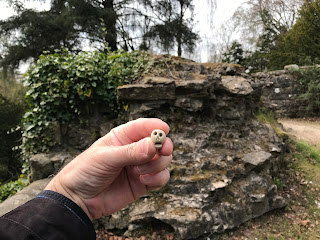If you were out on your travels and you
stumbled across a pool of oily water, would you think that it must have some
special or miraculous properties?
Probably not. You would probably
just think – Yuk, what is that? This was
not the way they thought in Medieval times though. In the days before pollution and oil spills,
science, and modern medicine, anything out of the ordinary could and often
would seem to be something miraculous, something provided by God above to help
us mere mortals down here on earth. So it was with the oily waters that rise
from a spring in Liberton to form the Oyly Well.
The Oyly Well, also known as the Balm
Well, St Catherine’s Well, or the Balm Well of St Katherine, sits in what were
once the grounds of St Catherine’s Chapel.
The chapel, which is now long gone, was built on the instructions of Queen
Margaret (later St Margaret of Scotland) in honour of St Catherine of Sienna.
The waters of the Oyly Well rise up from
a spring that passes through the oil shale in the ground below, and this is why
they are oily. In olden times though the
story went that Queen Margaret returned from Mount Sinai with some of the oil
of St Catherine, and being a bit of a clumsy clod, she somehow managed to spill
the oil on the spot where the spring rises.
This led to the waters becoming oily and having healing properties.
The well soon became famous for the curative
qualities of its water and was referred to locally as the Balm Well. It was said that the oily waters could cure
many skin complaints such as scabies.
They were also said to cure conditions leading to aching bones such as arthritis
and rheumatism while also helping to alleviate the symptoms of gout and
paralysis. And if drunk they were
supposedly good for preventing hysteria or breathing problems such as asthma.
The well was a big hit with the Scottish
royals and was visited by various kings. King James VI was a huge fan of the well and
believed fully in the healing properties of its waters. In 1617, on a trip back from England, where
he was of course King James I, he stopped off at the well and ordered that it
be properly enclosed and have a stairwell constructed down to the water so that
it was easier to access. However, in 1650
some of Cromwell’s soldiers, who were camped nearby, destroyed the structure
around the well and filled it in. During the Reformation the well was cleared of
rubble and partially rebuilt, with the full structure that is there now being
constructed in 1889.
Today the well can be found in a quiet
spot in the garden at the back of a rather grand house which stands in the area
where St Catherine’s Chapel once stood. The
house was built in 1806 for the architect John Simpson, and it was also the one
time home of Sir William Rae, the Lord Advocate who oversaw the prosecution of
the infamous body snatchers and murderers, Burke and Hare. In its various incarnations since then the house
has been a children’s home and is now a Toby Carvery restaurant.
On my visit there I sat in the early
afternoon sun and watched the oily waters of the well bubble away. Was I tempted to try them to alleviate any of
my aches and pains, rub them onto my arthritic knees or have a swig to cure my
wheezing hay fever? Nah – no
chance.
I left the Skulferatu that accompanied
me on my walk in a little dimple in the stone roof of the well, but then I gave
into temptation and…
Alas dear reader, I did something
I shouldn’t have oughta
I threw the Skulferatu
Into the oily water…
The coordinates for the location of the
Skulferatu are –
Latitude 55.902881
Longitude -3.164044
I used the following sources for information on the Oyly Well –
Canmore – Balm Well
The Scotsman - Monday 11
March 1889
The Oyly Well; or a
Topographico-Spagyrical Description of the Oyly-Well, at St. Catharines Chappel
in the Paroch of Libberton,
By Matthew Mackail, 1664
New Statistical Account
of Scotland – Volume 1
By the Ministers of the
Respective Parishes, etc.
1845
Proceedings of the
Society of Antiquaries of Scotland - Volume 17
‘Holy Wells’ in Scotland
By J Russell Walker
1883
.JPG)
.JPG)
.JPG)
.JPG)
.jpg)
.JPG)
.JPG)
.jpg)











